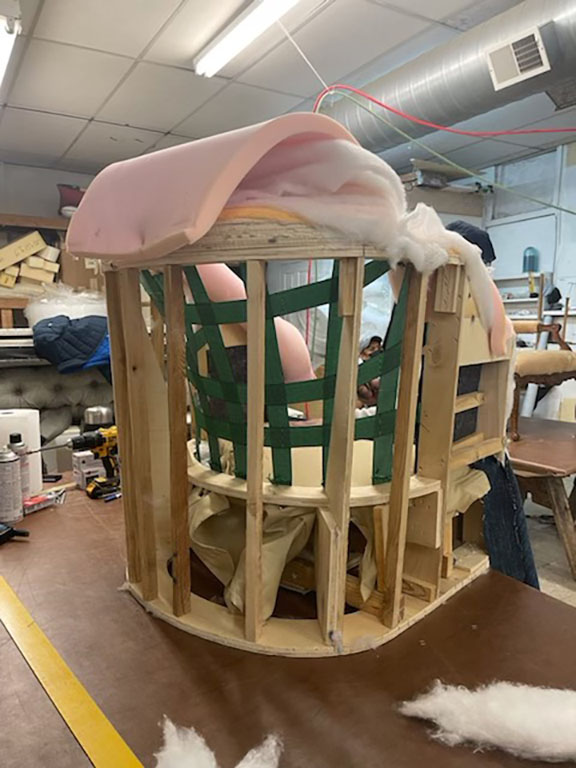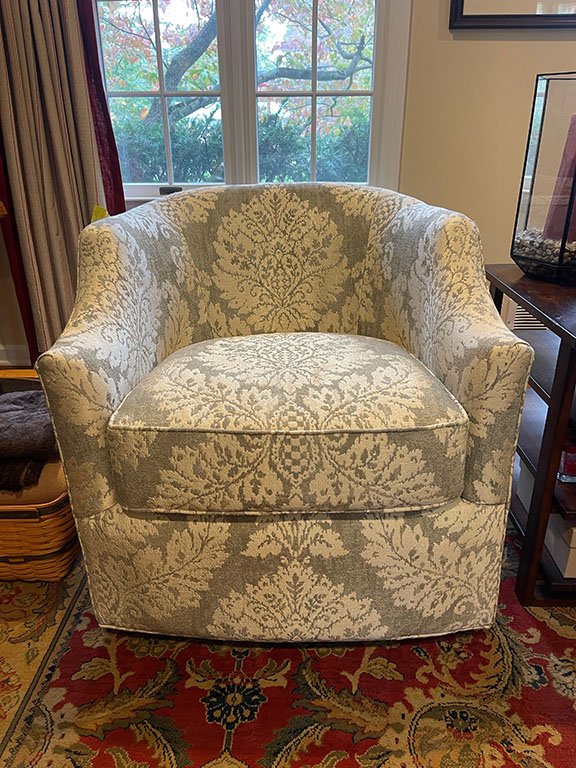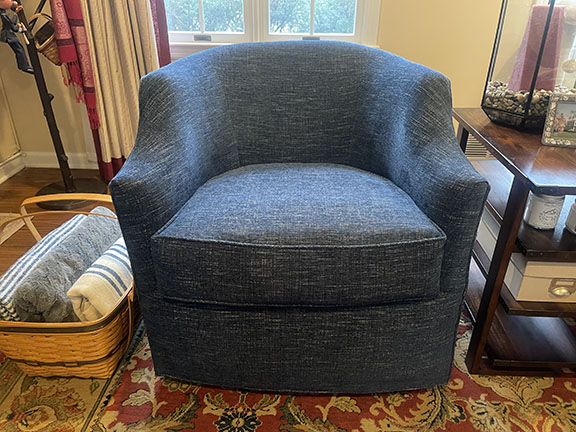By Elizabeth Wulfhorst

Saving a comfortable piece of furniture from a landfill by giving it new life through reupholstering may leave you feeling quite virtuous. But it can also leave your wallet feeling much lighter. Knowing when to reupholster and when to buy new can involve a pros and cons list that will sometimes tip toward emotion more than logic.
There are basically three options for giving an old chair or sofa new life: reupholstering, recovering or slip covering.
“Reupholstering is going down to the bones, taking everything off and redoing” the piece, said Kelley Duddy, owner of Peary Upholstery at 58 First Ave. in Atlantic Highlands. Slipcovering, on the other hand, leaves the old fabric and underlying material in place. A new cover of fabric, shaped to fit the chair or couch, is created to “slip” over the entire item.
Recovering splits the difference. Old fabric may be removed or left in place and new fabric is secured over the top of it. With recovering, the interior fill remains untouched.
Each alternative has benefits and drawbacks. Slipcovering will generally be cheaper than reupholstering and, depending on the fabric chosen, the cover can be easily removed for washing. A slipcover also won’t affect the original fabric if it is something you may want to revert to in the future. Slipcovers may also be a good choice for homes with a more casual décor. But slipcovers, not being attached to the furniture, tend to slide and may not wear as well, becoming misshapen over time.
The benefits of reupholstering include being able to revive deflated cushions with new batting, foam or other fill, tightening webbing, removing unwanted decorative touches like tufts or buttons, and potentially even altering the shape of a piece. Reupholstering is also a more permanent, and therefore usually more durable, solution. With those benefits often comes a much higher price tag.

Although still not inexpensive, recovering is often the cheapest option and can be a quick fix when the item is in good shape and a simple change of pattern or color is desired. It’s like giving a room a fresh coat of paint. Duddy said fabric removal may still be necessary with recovering, if the old pattern is busy or much darker than the new fabric.
One of the reasons reupholstering an old piece can be more expensive than buying new is the time involved in removing all the old material. “That is really time consuming, taking off all the old secrets,” Duddy said. “And sometimes you’re like, ‘Well, look at this. Why did this person put 500 gazillion nails or staples in here?’ ”
She said knowing what materials to keep and what to toss is a judgment call that comes from years of experience. “Sometimes we’ll keep some of what is there, within reason. It’s not like everything goes down to the nitty-gritty all the time. If you can save part of it there’s no reason to put everything in the dumpster.”
Once everything has been removed, “you build from there,” Duddy said. She looks at each piece and tries to “bring it back to life.”
Another main expense when reupholstering is, of course, the new fabric to cover the piece.
“Fabrics have come such a long way,” Duddy said. She carries hundreds of quality fabrics that start at about $40 per yard but can reach as high as $300, with the average starting price for a durable performance fabric hovering around $70 a yard. She said she tries to explain the benefits of each fabric and why the price points may differ and works within a person’s budget.
Tricia Nelson of British Cottage at 126 Shrewsbury Ave. in Red Bank watches fabric trends closely so she can advise customers on the best options when they are buying new pieces from her shop.
“Performance fabrics are the norm now,” she said, noting that several brands offer the option with names like Crypton, InsideOut and Sunbrella. “The technology has advanced to where there’s a chemical process that makes the fabric, in layman’s terms, so it doesn’t absorb mois- ture,” Nelson said. Most are odor, pet and stain resistant.
“I’ve actually seen people spill a bottle of soy sauce on a couch at a furniture show and it just does not get absorbed,” she said.
As far as colors go, Nelson said, “We’re still in our neutral colors zone, which makes sense because a sofa is a very big purchase. It’s better to keep your sofa neutral and then go crazy with pillows and accessories.”

A new Century brand sofa – the company guarantees its frames for 45 years – with a performance fabric might start around $3,000 at British Cottage. As Nelson pointed out, reupholstering a sofa can cost much more than that. It takes about 22 yards of fabric to cover a sofa; at $100 per yard, fabric alone could cost $2,200, before adding in the additional expenses of fill materials and labor.
Nelson said reupholstering can be a good option and worth the expense if the piece is unique in some way. She said she’s has slipcovered and twice reupholstered a sofa she bought 30 years ago for $150 at a second-hand shop. “It’s a really, really unique frame. It’s a Chippendale style. You’ll never find it in a million years,” she said.
Duddy said COVID-19 has also resulted in price increases. While she noted the supply chain is much better, with fabrics arriving fairly quickly, the cost of materials has skyrocketed.
One other factor in the cost of reupholstering is the skill, talent and artistry of the upholsterer.
Duddy said she works with a few different upholsterers and, “interestingly, they all have their own way of doing it.” From start to finish, she said, one chair can take about 16 hours to reupholster.
“There’s a lot of sewing involved. You lay out the fabric, you do your pattern and then you sew it and then you have to sew all the welt and then figure out where to put everything,” Duddy explained.
“And each case is different, too,” she said, which is why she can’t offer a set price list.
Nelson said there are some brands she would not spend the money to reupholster. “I would argue, like a Baker, Henredon, Century couch, I would recover. I would never recover a Pottery Barn couch,” she said.
Duddy thinks the comfort of the piece and how well it fits in your space are two factors which can help determine whether you should reupholster a piece or buy new. She said she has reupholstered everything from antique heirlooms to a chair that was mostly made of cardboard with “no judgment.”
And, after assessing all the options, Duddy said she understands when some people decide reupholstering isn’t worth the cost. “It doesn’t happen a lot, but I don’t blame them.”
This article originally appeared in the March 17 – 23, 2022, print edition of The Two River Times.














